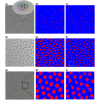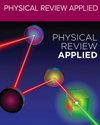Machine-learning-based detection of spin structures
IF 3.8
2区 物理与天体物理
Q2 PHYSICS, APPLIED
引用次数: 0
Abstract
One of the most important magnetic spin structures is the topologically stabilized skyrmion quasiparticle. Its interesting physical properties make it a candidate for memory and efficient neuromorphic computation schemes. For device operation, the detection of the position, shape, and size of skyrmions is required and magnetic imaging is typically employed. A frequently used technique is magneto-optical Kerr microscopy, in which, depending on the sample’s material composition, temperature, material growing procedures, etc., the measurements suffer from noise, low contrast, intensity gradients, or other optical artifacts. Conventional image analysis packages require manual treatment, and a more automatic solution is required. We report a convolutional neural network specifically designed for segmentation problems to detect the position and shape of skyrmions in our measurements. The network is tuned using selected techniques to optimize predictions and, in particular, the number of detected classes is found to govern the performance. The results of this study show that a well-trained network is a viable method of automating data preprocessing in magnetic microscopy. The approach is easily extendable to other spin structures and other magnetic imaging methods.

基于机器学习的自旋结构检测
最重要的磁性自旋结构之一是拓扑学上稳定的 Skyrmion 准粒子。其有趣的物理特性使其成为存储器和高效神经形态计算方案的候选者。在设备运行过程中,需要检测skyrmions的位置、形状和大小,通常采用磁成像技术。经常使用的一种技术是磁光克尔显微镜,根据样品的材料成分、温度、材料生长过程等,测量结果会出现噪声、低对比度、强度梯度或其他光学伪影。传统的图像分析软件包需要人工处理,因此需要一种更加自动化的解决方案。我们报告了一种专为分割问题设计的卷积神经网络,用于检测测量结果中天幕的位置和形状。我们使用选定的技术对该网络进行了调整,以优化预测结果,特别是发现检测到的类别数量会影响预测结果。研究结果表明,训练有素的网络是磁显微镜数据预处理自动化的可行方法。这种方法很容易扩展到其他自旋结构和其他磁成像方法。
本文章由计算机程序翻译,如有差异,请以英文原文为准。
求助全文
约1分钟内获得全文
求助全文
来源期刊

Physical Review Applied
PHYSICS, APPLIED-
CiteScore
7.80
自引率
8.70%
发文量
760
审稿时长
2.5 months
期刊介绍:
Physical Review Applied (PRApplied) publishes high-quality papers that bridge the gap between engineering and physics, and between current and future technologies. PRApplied welcomes papers from both the engineering and physics communities, in academia and industry.
PRApplied focuses on topics including:
Biophysics, bioelectronics, and biomedical engineering,
Device physics,
Electronics,
Technology to harvest, store, and transmit energy, focusing on renewable energy technologies,
Geophysics and space science,
Industrial physics,
Magnetism and spintronics,
Metamaterials,
Microfluidics,
Nonlinear dynamics and pattern formation in natural or manufactured systems,
Nanoscience and nanotechnology,
Optics, optoelectronics, photonics, and photonic devices,
Quantum information processing, both algorithms and hardware,
Soft matter physics, including granular and complex fluids and active matter.
 求助内容:
求助内容: 应助结果提醒方式:
应助结果提醒方式:


